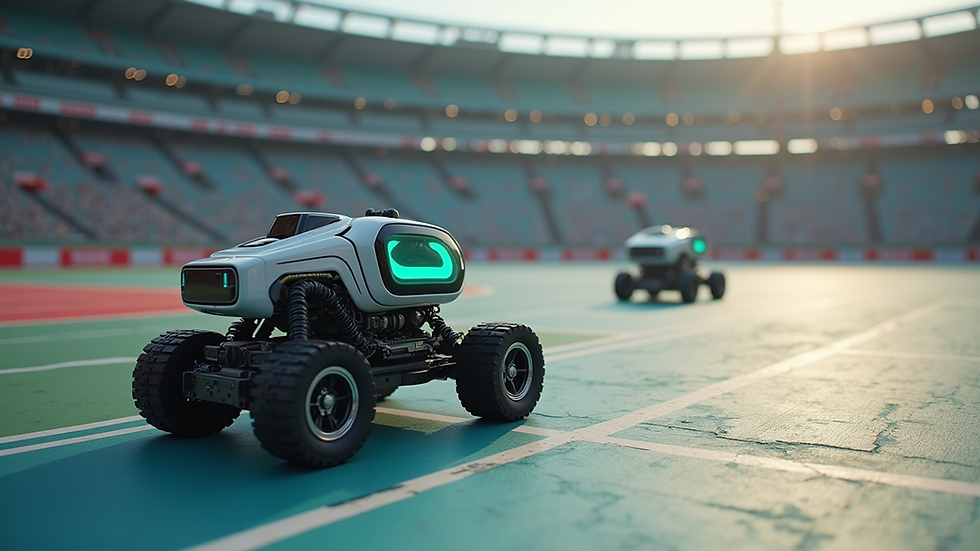Beginner-Friendly AI Classes Explained
- theteamfusionusa
- Sep 29
- 4 min read
Artificial Intelligence (AI) is no longer just a futuristic concept—it's here, and it's transforming the world around us! If you’re curious about how kids can dive into this exciting field, you’re in the right place. Today, I’m going to walk you through beginner-friendly AI education, perfect for young learners eager to explore robotics, coding, and STEM. Whether your child is just starting out or already fascinated by robots and competitions like First Lego League (FLL) or First Tech Challenge (FTC), this guide will help you understand how AI classes can open doors to a bright future!
What Is Beginner AI Education and Why Does It Matter?
Let’s start with the basics. Beginner AI education is all about introducing kids to the fundamental ideas behind artificial intelligence in a fun, hands-on way. It’s not just about coding or robots—it’s about teaching problem-solving, creativity, and critical thinking. These skills are essential for the future, especially in STEM fields.
Imagine your child building a robot that can recognize objects or solve puzzles. That’s AI in action! Beginner AI education breaks down complex concepts into bite-sized lessons that kids can grasp easily. Plus, it encourages teamwork and innovation, which are key in robotics competitions like FLL and FTC.
Why is this important? Because AI is everywhere—from smart assistants to self-driving cars. Early exposure helps kids become confident creators, not just consumers, of technology. It’s a fantastic way to prepare them for careers in engineering, computer science, and beyond.

How Beginner AI Education Works: What to Expect
You might wonder, “What exactly happens in beginner AI education?” Great question! These programs usually combine coding, robotics, and AI concepts through interactive projects. Here’s what you can expect:
Hands-on learning: Kids build and program robots or AI models using kid-friendly tools like Scratch, Micro:bit, Cute-bot, Python etc
Step-by-step lessons: Concepts like machine learning, pattern recognition, and decision-making are introduced gradually.
Real-world applications: Students see how AI powers things like voice recognition, games, and even robots in competitions.
Collaborative projects: Working in teams helps kids develop communication and leadership skills.
Fun challenges: Many programs include competitions or showcases to motivate kids and celebrate their progress.
For example, a typical session might start with a simple coding exercise, then move on to programming a robot to navigate a maze using sensors. This mix of theory and practice keeps kids engaged and excited!
If you’re interested in finding quality ai classes that offer this kind of experience, there are plenty of options designed specifically for young learners.

Can I Learn AI by Myself?
Absolutely! AI is a field that welcomes self-learners of all ages. But when it comes to kids, especially those in elementary or middle school, guided learning is often more effective. Here’s why:
Structured guidance: AI concepts can be tricky. Having a teacher or mentor helps clarify doubts and keeps learning on track.
Hands-on support: Robotics and coding require tools and troubleshooting that are easier with supervision.
Motivation and encouragement: Learning with peers or in a class setting boosts enthusiasm and persistence.
Access to resources: Classes often provide curated materials, software, and hardware kits that are kid-friendly.
That said, if you want to support your child’s self-learning journey, there are tons of free and paid resources online. Websites, YouTube tutorials, and coding apps can be great supplements. Just remember, combining self-study with interactive classes or clubs can make the experience richer and more rewarding.
How Robotics Competitions Tie Into AI Learning
Robotics competitions like First Lego League (FLL) and First Tech Challenge (FTC) are fantastic platforms for kids to apply AI and coding skills in real-world scenarios. These competitions challenge teams to design, build, and program robots to complete specific tasks—often involving AI elements like sensor data processing or autonomous navigation or AI based research & creation for solving a real world challenge.
Participating in these competitions helps kids:
Develop problem-solving skills: They learn to troubleshoot and iterate on their designs.
Work as a team: Collaboration is key to success.
Gain confidence: Presenting their projects and competing builds self-esteem.
Experience STEM in action: They see how AI and robotics solve real problems.
Many beginner AI education programs prepare kids specifically for these competitions, making the learning process goal-oriented and exciting. If your child loves challenges and teamwork, this is a perfect way to deepen their AI knowledge.

How to Choose the Right AI Classes for Your Child
With so many options out there, picking the right AI classes can feel overwhelming. Here are some tips to help you make the best choice:
Age-appropriate curriculum: Look for programs tailored to your child’s grade level and experience.
Hands-on projects: Ensure the class includes plenty of interactive activities.
Qualified instructors: Experienced teachers who can explain concepts clearly and encourage creativity are a must.
Small class sizes: This allows for personalized attention and better learning outcomes.
Integration with competitions: If your child is interested in FLL or FTC, find classes that prepare students for these events.
Flexible scheduling: Consider your family’s routine and choose classes that fit comfortably.
Positive reviews: Check testimonials from other parents and students.
Remember, the goal is to make learning AI fun and accessible. Don’t hesitate to reach out to program coordinators with questions before enrolling.
I hope this guide has sparked your excitement about beginner AI education! If you want to explore some fantastic ai classes that combine robotics, coding, and AI for kids, check out Fusion Education’s offerings. They’re dedicated to inspiring the next generation of engineers and innovators through hands-on STEM learning.
Your child’s journey into AI and robotics could start today—let’s make it an adventure full of discovery and success!



Comments